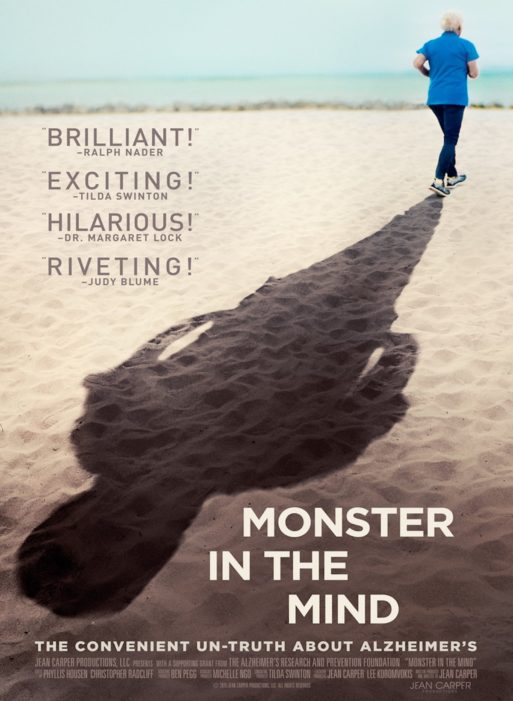 “Monster in the Mind” is a fascinating account of the history of Alzheimer’s disease, from its discovery in the early 20th century to the epidemic we’re facing today. It’s also a step-by-step debunking of the doomsday myths that have built up around the disease and caused so much fear. The documentary is also the story of the film’s director and featured guinea pig Jean Carper and her relationship to Alzheimer’s.
“Monster in the Mind” is a fascinating account of the history of Alzheimer’s disease, from its discovery in the early 20th century to the epidemic we’re facing today. It’s also a step-by-step debunking of the doomsday myths that have built up around the disease and caused so much fear. The documentary is also the story of the film’s director and featured guinea pig Jean Carper and her relationship to Alzheimer’s.
A former journalist who reported on the disease, Carper is also a carrier of the APOE 4 gene that’s been identified as a major risk factor for developing it. She is a patient who has requested a PET scan to measure the amount of Alzheimer’s-predictive amyloid plaque in her brain. And she is an 80-year-old woman who started having nightmares that featured Dr. Alzheimer as a menacing character carrying the message that Carper was destined to develop the disease.
In the beginning of the film, Carper introduces herself and says that, at 80 years old, she’s “in my prime for getting Alzheimer’s and other dementias, and the world is in a panic over predictions that Alzheimer’s will be a demographic apocalypse by 2050, with more than 135 million people projected to have dementia.”

Jean Carper
Credit: stopagingnow.com
The film starts out with a series of doomsday predictions about the current Alzheimer’s epidemic and how much more severe it will become by the year 2050 if scientists haven’t found a cure. William Thies, senior scientist at the Alzheimer’s Association is seen saying, “The reality is if we don’t find a way to prevent Alzheimer’s disease, we are going to see in most of the cities of the world demented people wandering the streets.”
We learn that Alzheimer’s was first discovered in a woman in an asylum in Germany in the early 20th century and named after the doctor who treated her. At that time, the disease was rare, and nobody in the medical community paid much attention.
We also learn that the National Institute of Health came up with a plan in the late 1970’s to put Alzheimer’s on the map for the scientific and medical communities and bring it into the public discourse. At that time, the agency brought in Zaven Khachaturian, the former director of the office of Alzheimer’s research at the NIH, to implement the plan. With the participation of Congress, Khachaturian encouraged pharmaceutical companies to search for a cure for the disease. The plan was very successful, but it generated some negative consequences. Most importantly, it caused an immense amount of fear and used stigmatizing language to paint a portrait of the Alzheimer’s patient as a sort of zombie.
As Khachaturian said, the best way to legitimize the disease was to “… show that this causes real suffering — claim that it destroys the selfhood of people and the cruelest thing is that people go on living life as a hollow shell. This is dramatically stigmatizing language that starts to create much more fear around these symptoms.”
Jean Carper was one of the journalists who reported on Alzheimer’s during this campaign. She laments now that she was “part of the propaganda machinery to sell Alzheimer’s to the public.”
Not as Scary as It Seems
The rest of “Monster in the Mind” is full of surprising information, as Carper talks to Alzheimer’s researchers at the top of their field. We learn that her fears have diminished as more promising prognostics and statistics have come out. For example, while it’s true that we will continue to face a growing epidemic of Alzheimer’s disease because of the sheer numbers of people who are over 65 (predicted to reach 1.5 billion by the year 2050), the actual risk of developing dementia is going down. A 75-year-old today has a 24 percent lower risk of developing dementia than a 75-year-old did 20 years ago, according to Kenneth Langa, professor of gerontology at the University of Michigan.

Jean Carper exercises on the beach
Credit: clevelandfilm.org
At the end of the film, Carper receives the results of a PET scan she requested to determine whether there was amyloid plaque built up in her brain. (The amyloid hypothesis posits that Alzheimer’s is caused by an excess of amyloid in the brain. And there’s no doubt that amyloid plays a role in the disease. But, as the researchers in the film point out, no proof exists that amyloid plaque causes Alzheimer’s disease.) Her PET scan is clear, and Carper is shocked. After all, she’s 80 years old and carries the APOE 4 gene. But the doctor who tells her about her PET scan also tells her that physical activity, mental stimulation and social engagement can, perhaps, neutralize the effects of the APOE 4 gene.
In the end, the most important message of the film is that Alzheimer’s is not a “monster” striking at random that we are powerless to prevent. Individual lifestyle choices can influence if and when a person develops the disease. The film starts off very grim, but ends on an empowering note. In between, the endearing, spirited Carper provides a lot of fascinating information about dementia and Alzheimer’s that will, hopefully, leave the viewer a bit less afraid of this “Monster in the Mind.”

 “Monster in the Mind” By Jean Carper
“Monster in the Mind” By Jean Carper


 The Spiritual Symbolism of Cardinals
The Spiritual Symbolism of Cardinals
 Meaning-Focused Grief Therapy: Imaginal Dialogues with the Deceased
Meaning-Focused Grief Therapy: Imaginal Dialogues with the Deceased
 Flawed Kidney Function Test Discriminated Against Black Patients
Flawed Kidney Function Test Discriminated Against Black Patients














